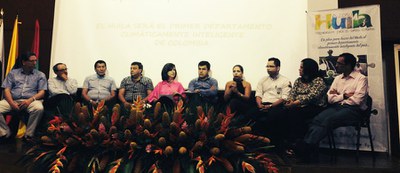Launch of Huila’s Climate Change Plan: Huila 2050

The Huila 2050 project was developed for FCMC by E3, headed up by Claudia Martínez Zuleta. The plan integrates climate change mitigation and adaptation in a single approach, with a long term development vision to assure that Huila continues to be economically competitive and well adapted to future climate conditions. The Plan has five main programmatic components: Water (the central issue around which other issues revolve); Biodiversity and Ecosystem Services; Agricultural Production and Food Security; Energy Resources; and Resilient Environments. It also proposes actions in four crosscutting areas: Territorial Zoning, Education and Training, Communication, Science and Technology, and Risk Management.
The launch event got underway with speeches by the Governor of Huila; Danielle Spinard, Deputy Director of the Environment Office at USAID/Colombia; and the Vice-Minister of Environment and Sustainable Development of Colombia. Governor Iriarte spoke about the strategic importance of the department of Huila for Colombia, in terms of provision of water and other environmental services, the production of significant agricultural goods and the generation of electricity. Mrs. Spinard congratulated the department in the name of FCMC and USAID for the impressive results of the project. She said that USAID sees the Plan as a very innovative way of promoting climate compatible development. Vice-minister Vieira stated that Huila is an excellent example for the rest of Colombia and that having department-wide plans that integrate mitigation and adaptation is ideal.
After the initial speeches, Carlos Cuellar, Director of CAM, formally presented the Climate Change Plan for Huila. He emphasized the importance of viewing the Plan not solely as an environmental strategy but rather as a long-term development plan, and invited all of the different stakeholders in the region to work together for implementation. Subsequently, a panel discussion with representatives of the Departmental Climate Change Council was held, moderated by Claudia Martínez. The principal question discussed was how to move forward to implement the Plan. Among the panelists were the directors of the regional coffee growers and cattle rangers committees, and Rodrigo Suárez, Director of Climate Change at the Ministry of Environment and Sustainable Development. The panelists proposed concrete ideas within their own sectors.
Since one of the priorities of Plan Huila 2050 is to educate the department’s population with regards to climate change, a final session was held with two local child theater groups related to environment and climate change.
The launch established groundwork for the Plan’s implementation. All agreed it will be crucial to maintain momentum and work to translate current enthusiasm into concrete actions to convert Huila into a climate-smart territory. Ultimately, the idea is that climate compatible development will increase opportunity and well-being. The continued and committed participation of different stakeholders at the local, regional, national and international level will be crucial.
The Huila 2050 project has a technical committee, including experts from national and regional institutions, and international advisors from the Stockholm Institute, Abt Associates and CATIE. Huila 2050 is viewed as an example of an innovative climate change approach by the other Departments of Colombia. The project is coordinated though the Regional Environmental Corporation, CAM, and is serving as an umbrella project that unifies institutions, projects and sectors of the department, with a common goal of assuring development that is compatible with the future climate. For more information on the Huila 2050 project, please review the related series of reports at here.

